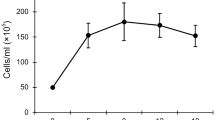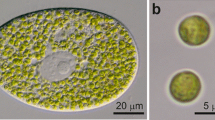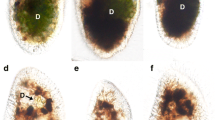Abstract
The endosymbiotic unit of Paramecium bursaria and Chlorella spec. shows two types of photobehaviour: 1) A step-up photophobic response which possibly depends on photosensitive agents in the ciliate cell itself — as is also shown by alga-free Paramecium bursaria - and can be drastically enhanced by photosynthetic activity of symbiotic algae; and 2) a step-down photophobic response. The step-down response leads to photoaccumulation of green paramecia. Both types of photobehaviour in Paramecium bursaria do not depend on any special kind of algal partners: The infection of alga-free Paramecium bursaria with different Chlorella species results in new ciliatealgae-associations. They are formed not only by combination of the original symbiotic algae with their host, but also by infection with other symbiotic or free-living (aposymbiotic) chlorellae, respecitively. Systems with other than the original algae are not permanently stable — algae are lost under stress conditions — but show the same types of photobehaviour. Photoaccumulation in general requires algal photosynthesis and occurs only with ciliates containing more than fifty algae/cell. It is not mediated by a chemotactic response to oxygen in the medium, since it occurs at light fluence rates not sufficient for a release of oxygen by the symbiotic system, e.g., below its photosynthetic compensation point. Photoresponses can be inhibited by 3-(3′,4′-dichlorophenyl)-1,1-dimethylurea (DCMU). Sensory transduction does not depend on any special symbiotic features of the algae, e.g., sugar excretion. The participation of oxygen in the Paramecium cell, of its cytoplasmic pH and of ions released or taken up by endosymbiotic algae in sensory transduction is discussed.
Similar content being viewed by others
References
Barber, J. (1968) Measurements of the membrane potential and evidence for active transport of ions in Chlorella pyrenoidosa. Biochim. Biophys. Acta 150, 618–625
Buchsbaum-Pearse, V. (1974) Modification of sea anemone behaviour by symbiotic zooxanthellae: phototaxis. Biol. Bull. 147, 630–640
Cronkite, D., van den Brink, S. (1981) The role of oxygen and light in guiding “photoaccumulation” in the Panamecium bursaria-Chlorella symbiosis. J. Exp. Zool. 217, 171–177
Doughty, M.J., Dryl, S. (1981) Control of ciliary activity in Paramecium: an analysis of chemosensory transduction in a eukaryotic unicellular organism. Prog. Neurobiol. 16, 1–115
Iwatsuki, K., Naitoh, Y. (1981) The role of symbiotic Chlorella in photoresponses of Paramecium bursaria. Proc. Jpn. Acad. 57, 318–323
Karakashian, S.J., Karakashian, M.W., Rudzinska, M.A. (1968) Electron microscopic observations on the symbiosis of Paramecium bursaria and its intracellular algae. J. Protozool. 15, 11–128
Keeble, F. (1910) Plant-animals: a study in symbiosis. University Press, Cambridge
Muscatine, L., Karakashian, S.J., Karakashian, M.W. (1967) Soluble extracellular products of algae symbiotic with a ciliate, a sponge and a mutant hydra. Comp. Biochem. Physiol. 20, 1–12
Niess, D., Reisser, W., Wiessner, W. (1981) The role of endosymbiotic algae in photoaccumulation of green Paramecium bursaria. Planta 152, 268–271
Okumura, H. (1964) Membrane permeability and response to light in Paramecium. J. Fac. Sc. Hokkaido Univ. Ser. VI 15, 480–488
Raven, J.A. (1976) Transport in algal cells. In: Encyclopedia of plant physiology, N.S., vol. 2, pp. 129–188, Lüttge, U., Pitman, M.G., eds. Springer, Berlin Heidelberg New York
Reisser, W. (1975) Zur Taxonomie einer auxotrophen Chlorella aus Paramecium bursaria Ehrbg. Arch. Microbiol. 104, 293–295
Reisser, W. (1976a) Die stoffwechselphysiologischen Beziehungen zwischen Paramecium bursaria Ehrbg. und Chlorella spec. in der Paramecium bursaria Symbiose. I. Der Stickstoff-und der Kohlenstoffwechsel. Arch. Microbiol. 107, 357–360
Reisser, W. (1976b) Die stoffwechselphysiologischen Beziehungen zwischen Paramecium bursaria Ehrbg. und Chlorella spec. in der Paramecium bursaria Symbiose. II. Symbiosespezifische Merkmale der Stoffwechselphysiologie und der Cytologie des Symbioseverbandes und ihre Regulation. Arch. Microbiol. 111, 161–170
Reisser, W. (1981) Host-symbiont interaction in Paramecium bursaria: physiological and morphological features and their evolutionary significance. Ber. Dtsch. Bot. Ges 94, 557–563
Saji, M., Oosawa, F. (1974) Mechanism of photoaccumulation in Paramecium bursaria. J. Protozool. 21, 556–561
Scott-Henry, A., Nielsen, P.J. (1980) The phototactic action spectrum of Paramecium bursaria. J. Protozool. 27, 32–33A
Walker, E.B., Yoon, M., Song, P.-S. (1981) The pH dependence of photosensory responses in Stentor coeruleus and model system. Biochim. Biophys. Acta 634, 289–308
Ziesenisz, E., Reisser, W., Wiessner, W. (1981) Evidence of de novo synthesis of maltose excreted by endosymbiotic Chlorella from Paramecium bursaria. Planta 153, 481–485
Zmiri, A., Rahat, M. (1971) A phototactic response in foraminifera. J. Protozool. 18, 36–37
Author information
Authors and Affiliations
Rights and permissions
About this article
Cite this article
Niess, D., Reisser, W. & Wiessner, W. Photobehaviour of Paramecium bursaria infected with different symbiotic and aposymbiotic species of Chlorella . Planta 156, 475–480 (1982). https://doi.org/10.1007/BF00393320
Received:
Accepted:
Issue Date:
DOI: https://doi.org/10.1007/BF00393320




